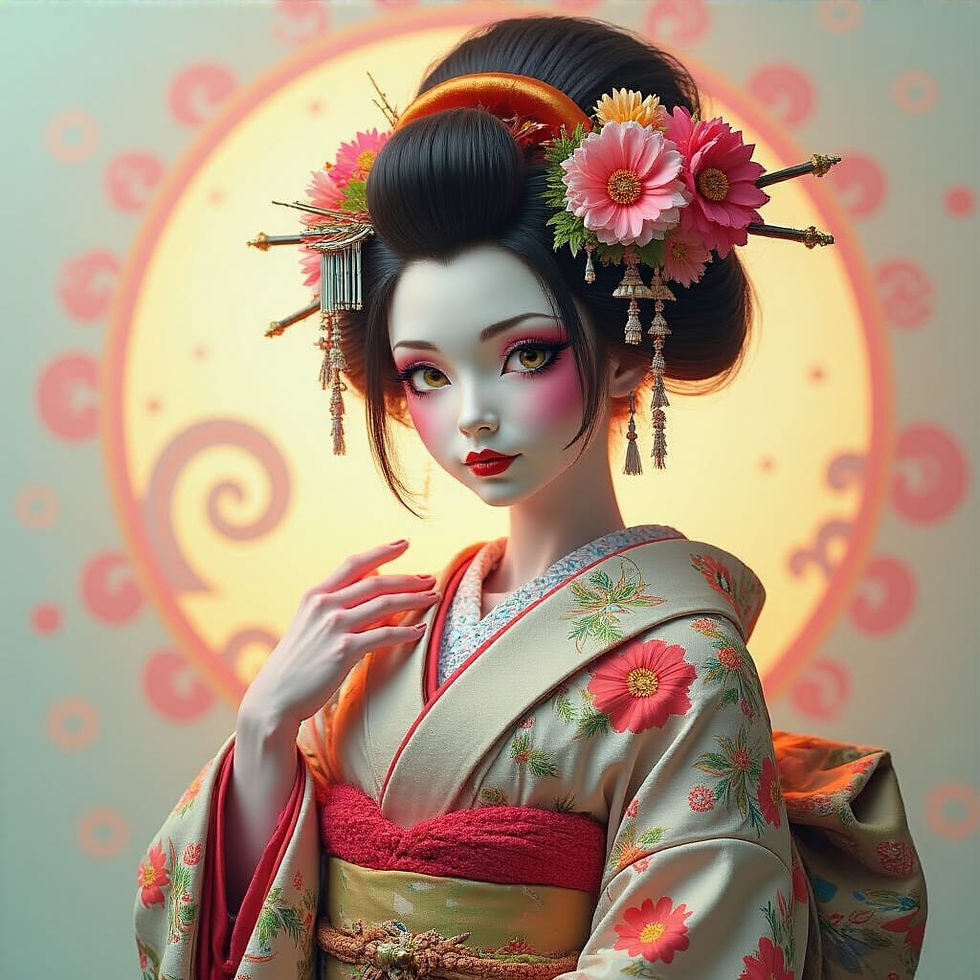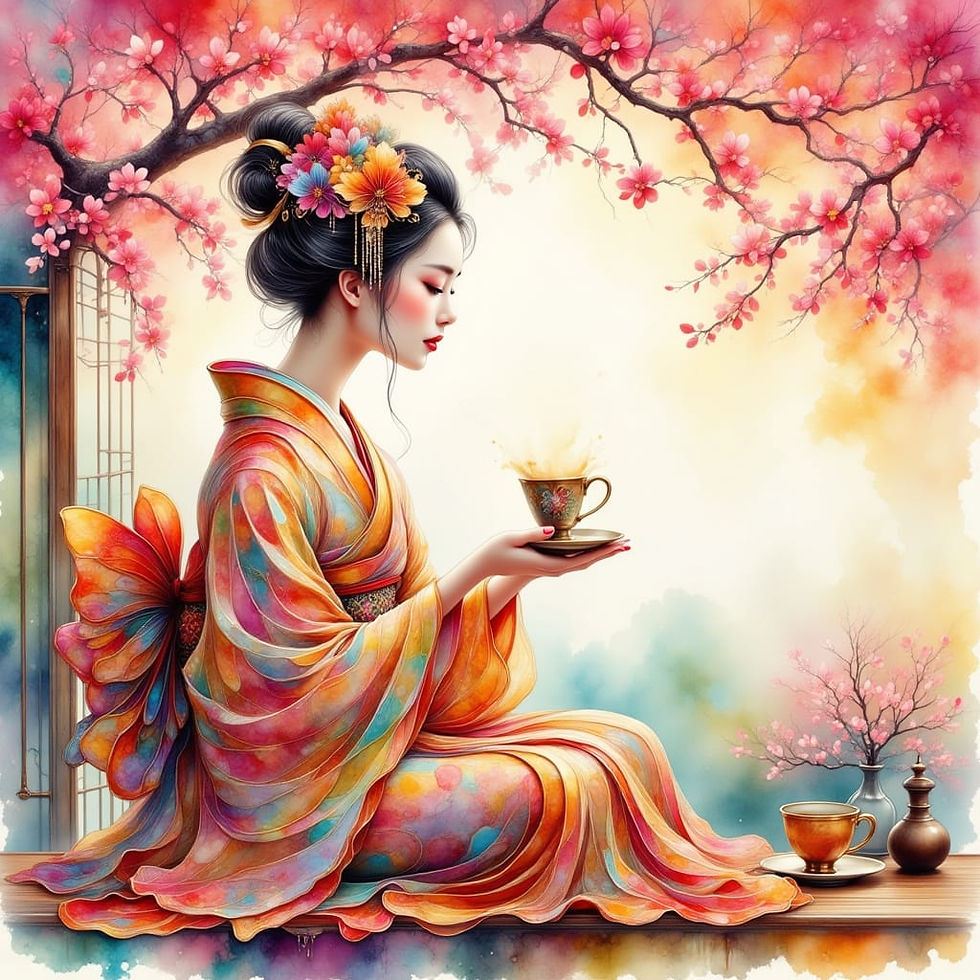The Timeless Elegance of Geisha: Journeying Through History and Values
- Larisa Ion
- Jun 6
- 4 min read
Geisha have long symbolized the grace and tradition of Japanese culture. With their exquisitely crafted kimonos and beautifully painted faces, they have fascinated audiences worldwide. However, the story of geisha goes beyond their stunning appearance. It is a narrative imbued with rich cultural significance and evolving values. This post invites you to explore the journey of geisha from their origins to the present day, shedding light on the values they represent and their broader impact on society.
The Origins of Geisha Culture
The origins of geisha culture can be traced back to the 18th century during Japan's Edo period. Initially, geisha were women who entertained guests in teahouses, offering music, dance, and engaging conversation. These functions quickly evolved, setting the groundwork for what we now recognize as geisha culture.
By the late 19th century, the role of geisha transformed considerably. They became emblematic of refined entertainment, not just as performers but as custodians of various arts, including the tea ceremony and traditional music. The values of beauty, discipline, and artistry became integral, cultivating respect for geisha and their unique craft.
The intricate kimonos and elaborate hairstyles, hallmarks of a geisha's appearance, carry historical significance. For example, a geisha may wear a specific kimono design that reflects her age, status, or expertise in the arts, making each garment a piece of living history.
The Geisha’s Craft: Training and Discipline
To become a geisha, one must undergo extensive training, typically starting as a maiko or apprentice. This process can take anywhere from two to six years. Apprentices learn various skills, including traditional dance, music, and the art of conversation, while also embracing the values of humility, patience, and respect.
The training houses, known as okiya, become a nurturing environment where discipline is instilled. This method aligns with Japan's emphasis on lifelong learning and mastery. It's not uncommon for a geisha to continue refining her skills even after years in the profession, exemplifying a commitment to excellence.
In today’s fast-paced world, a geisha’s dedication to her craft serves as a potent reminder of the importance of discipline and mastery in any endeavor.
Cultural Significance: A Living Tradition
Geisha are more than just entertainers; they are living embodiments of Japanese tradition. They stand at the intersection of art, history, and social interaction. In many respects, geisha act as cultural ambassadors, playing a crucial role in preserving and promoting traditional Japanese arts.
As societal norms have changed over the years, so has the perception of geisha. Once seen solely as entertainers, they are now increasingly recognized for their artistry and cultural contributions. For instance, events such as the Gion Matsuri festival in Kyoto highlight the skills of geisha, showcasing traditional arts to a broader audience.
However, preserving these traditions amidst modern pressures can be challenging. With the rise of globalization and casual lifestyles, the unique lifestyle and heritage of geisha can be overlooked. Nevertheless, many geisha actively work to uphold their traditions, hosting workshops and events that enlighten new generations about their artistry and values.
Contemporary Geisha: Adaptation and Resilience
The image of geisha continues to evolve in today's world. Some view them through an idealized lens, while others recognize their relevancy in contemporary times. Authentic geisha still operate in traditional teahouses, while some have adapted to platforms like social media, allowing them to reach a wider audience and showcase their skills.
Moreover, discussions about gender roles and empowerment are emerging around geisha culture. Many women perceive the choice to become a geisha as empowering, celebrating a profession steeped in femininity, strength, and artistry.
The balance between tradition and modernity reflects the resilience of this culture, showing that the values of grace, skill, and artistry remain cherished in contemporary society.
Values of the Geisha: Beyond Aesthetics
At the heart of the geisha tradition lie values that go far beyond mere aesthetics. Every detail, from their posture to the way they serve tea, embodies a deep-seated respect for the moment and the guests. This culture of hospitality and mindfulness is increasingly valued today, fostering deeper human connections.
Geisha also represent the importance of artistic integrity. Their dedication to their craft ensures that even amid societal changes, the essence of their artistry remains intact. For instance, the precision required in a traditional dance performance reflects a commitment to authenticity—a quality increasingly sought after in our trends-driven world.
Furthermore, the relationship between a geisha and her clients often exemplifies themes of mutual respect. These connections, built on shared experiences, foster a richer cultural exchange that extends beyond mere entertainment.
The Influence of Geisha on Global Culture
Geisha's allure has crossed borders, significantly influencing global art and culture. They serve as key figures in literature and films, often highlighting themes of tradition versus modernity, gender dynamics, and the nuances of cultural appreciation.
Nonetheless, portrayals of geisha in media can elicit mixed responses. While some celebrate their artistry, others risk oversimplifying or stereotyping their roles. It is essential to engage with geisha culture respectfully, recognizing its depth and the values it upholds.
By approaching geisha culture in an authentic manner, audiences worldwide can appreciate the beauty, artistry, and meaningful narratives that this timeless tradition offers.
Reflecting on the Legacy of Geisha
As we explore the history and values of geisha, we uncover a rich tapestry woven with tradition, artistry, and cultural significance. Despite the challenges they face in a rapidly changing world, geisha continue to embody values that resonate across cultures—discipline, respect, and the preservation of heritage.
Their elegance stands as a reminder of the beauty inherent in tradition and the artistry within our collective cultural narratives. As geisha adapt to modern realities, they encourage us to reflect on our values and inspire an appreciation for the artistry that surrounds us. Understanding and celebrating the world of geisha enriches our connection to the broader human experience.




Awesome explanation of the Geisha, so nice to have them explained for once and not just brushed off as japanese prostitutes, tyvm Saki
It is wonderful history. Well done, and thank you for sharing.